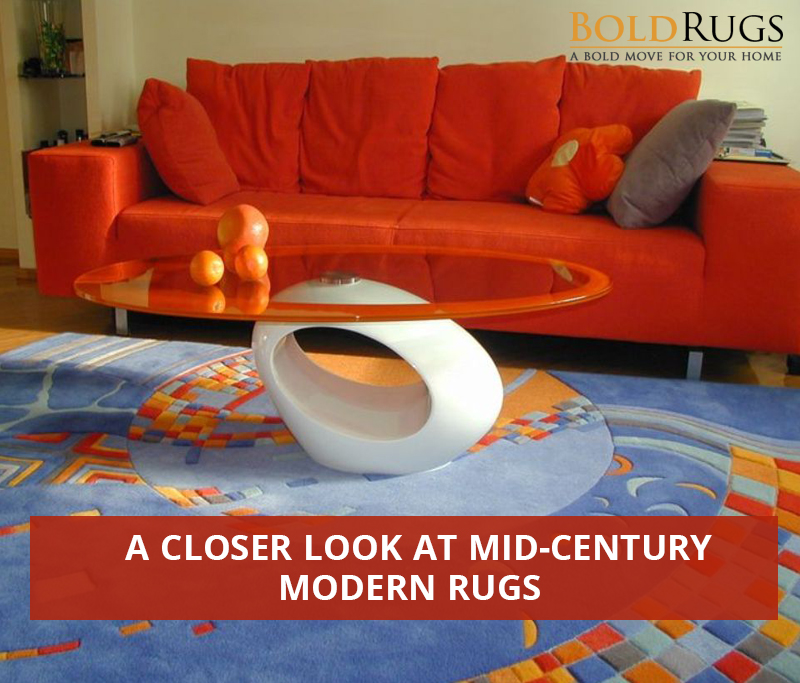Are you looking for a style to use when decorating your home? Do you want to go with something that’s on the forefront of current trends? If you find yourself searching for the right style selection and unsure of which is best for your home, we’re here to help you! Mid-century modern is one of the most popular methods of designing an interior space right now, and if you choose to go this route, you definitely won’t be at a loss for décor—including area rugs. However, you may still bit a little bit stumped as to what you’re looking for when you shop for a rug to fit into this category. If this is the case, be sure to take a look at the information we’ve put together below to help give you a crash course in mid-century modern rugs.
What is mid-century modern?
In order to understand what a mid-century rug is, you first need to know what constitutes “mid-century” in a design sense. Although this may sound like it focuses specifically on the 1950s, the term is actually a little bit broader than that. In most instances, mid-century in terms of home décor refers to the time between the 1930s and 1960s, give or take just a little bit. Most of the design themes that are prevalent within this type of décor include soft curves and sharp lines as well as contrasting fibers and materials throughout a room.
Much of this design trend was inspired by German designers when they relocated to the United States after World War II. Following the war, there was a boom in the world of interior design, and furniture soon became something intended just as much for show as it was for functionality. As these two changes in the United States combined, the mid-century modern style was born.
Some of the features of this style include geometric and abstract prints, functional pieces that are nevertheless still beautiful, contrasting or complementary colors and fibers, and a slight tendency toward minimalism—although true minimalism would not take off in the world of interior design for a few decades following this style.
This style fits snugly into the “modern” or “contemporary” category of area rugs in that it utilizes more fibers aside from simply wool and allows for abstract and geometric designs. This is also a good style to choose when you’re looking for something transitional, since you can easily incorporate more traditional colors or fibers into your mid-century modern room.
Mid-Century Modern Design Elements
There are several design elements to keep in mind when narrowing down which rugs are mid-century modern and which are not. Let’s take a quick look at each of these categories to get a better idea of what you should be searching for.
- Fibers: Function is a huge part of mid-century modern décor—including area rugs—and for this reason, plastic became more popular during this time period. Plastic furniture was more widely accepted, but synthetic fibers in area rugs also saw a surge of popularity. This was partly due to the fact that plastic could be more functional and durable in a busy home than natural fibers, and also because synthetic fiber rugs were more affordable in a postwar economy. However, the true sign of a mid-century modern room is the combination of several different design elements, so you may see both natural and manmade fibers happily existing together in the same space when you check out this design style.
- Patterns: Again, geometric and abstract patterns abound in the world of mid-century modern rugs. However, you may find some more standard patterns such as bold stripes and gentle flowing curves and circles as well. Some solid color rugs can be seen during this time period, but this is less common overall than patterned rugs. Floral prints remained popular throughout this time period as well.
- Colors: Almost any color can be seen in the mid-century modern style. While bolder, more vibrant colors were beginning to take root and become popular choices at this time, they wouldn’t become the true face of modern area rugs for a little while longer. Neutral and earth tones can still be seen throughout this style, and they can go a long way toward helping you balance a room with several different colors and textures going on in the same space. At this time, too, black and white began to be seen—albeit uncommonly—as a stark contrasting design element as well.
- Usage: Finally, the way in which a rug is used is a good indicator of whether or not it falls into the mid-century modern category. While most traditional and some transitional area rugs are used purely as decorative centerpieces without any real functionality behind them, a mid-century modern rug is a lot more likely to be chosen based on its ability to do a job in the household and look good at the same time. Rugs from this time are used as runners, dividers, or centerpieces in a room that sees a lot of foot traffic from the whole family.
There is a lot to keep in mind when you’re trying to choose an area rug that will fit into the mid-century modern décor style. However, if you love this style and want to make it work in your home, then you don’t have to worry too much about being able to find a rug that will fit smoothly into your favorite design trend. Many mid-century modern rugs are currently available on the market, and as long as the trend continues to be a popular one, they will continue to be made with new, fresh concepts every year. Now that you know a little bit more about what the style includes and what makes a rug truly mid-century modern, you’ll be better able to spot them when you go shopping. Keep your eyes peeled and you’re sure to find a great rug for your needs in no time.
